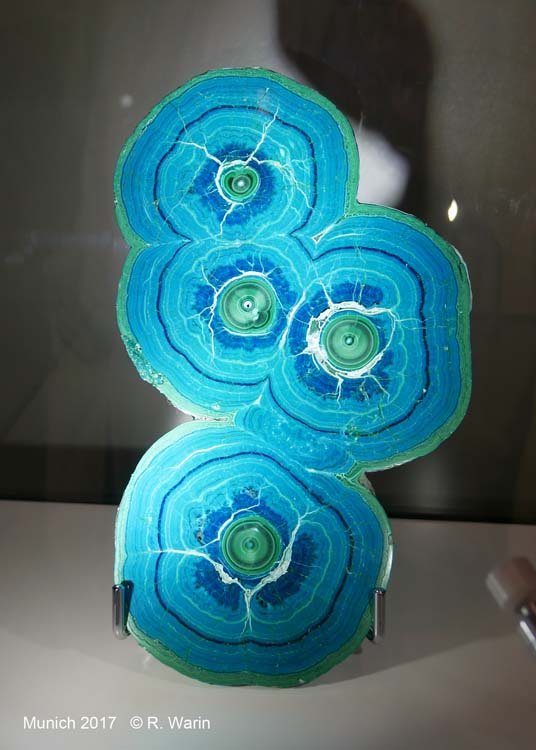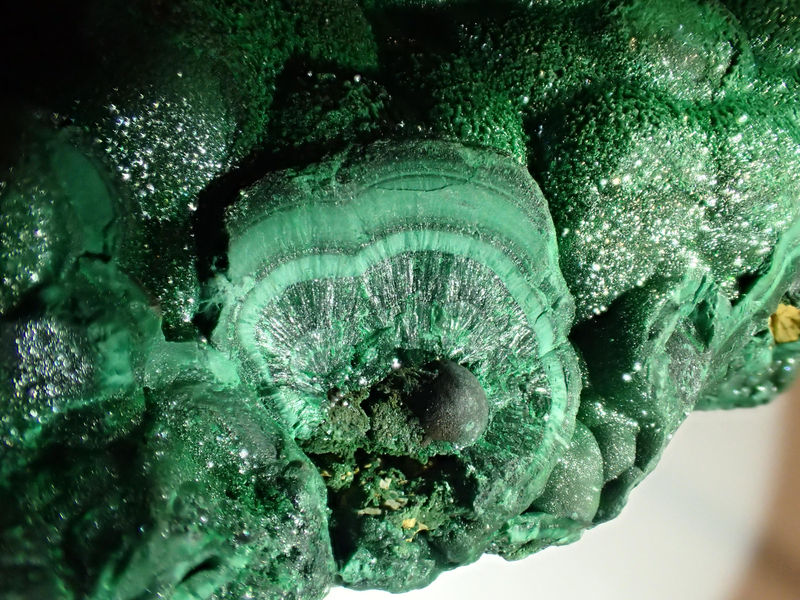| View previous topic :: View next topic |
| Author |
Message |
RayStraw
Joined: 21 Jul 2018
Posts: 47
Location: Bloomington Illinois


|
 Posted: Nov 01, 2019 19:48 Post subject: Color variation in azurite and malachite Posted: Nov 01, 2019 19:48 Post subject: Color variation in azurite and malachite |
|
|
Can anyone provide a reference to the cause(s) of color variation in layers of botyroidal azurite and malachite.
I think it is due to the size of the micro crystals.
Thanks for the information
Ray Straw
|
|
| Back to top |
|
 |
LeadMineGal
Joined: 18 Dec 2012
Posts: 31
Location: Westhampton, MA


|
 Posted: Nov 02, 2019 09:16 Post subject: Re: Color variation in azurite and malachite Posted: Nov 02, 2019 09:16 Post subject: Re: Color variation in azurite and malachite |
|
|
I had a few minutes so I googled your question and found this result:
"...As a final note, we can find information as to what causes the two species to be different colors. It seems that the structure is different enough to affect the absorption of the copper ions and perhaps the bond size as well so that azurite produces a blue color unlike the green we see in malachite. In 1979, Marfunin said the structure in azurite was arranged so that the copper ion was in elongated octahedral coordination while malachite was in octahedral coordination – the difference may translate to bond length and that can cause a slight change in the absorption and color you actually see."
I found it on Tucson Gem and Mineral Society (TGMS 'dot' org) with the link: bills-archive/2016/10/7/azurite-and-malachite
I hope it helps!
|
|
| Back to top |
|
 |
RayStraw
Joined: 21 Jul 2018
Posts: 47
Location: Bloomington Illinois


|
 Posted: Nov 02, 2019 11:59 Post subject: Re: Color variation in azurite and malachite Posted: Nov 02, 2019 11:59 Post subject: Re: Color variation in azurite and malachite |
|
|
Thank you for the information. I can use the reference for other problems I have.
I was not clear in what I wanted.
Botyroidal malachite often has different shades of green.
Botyroidal azurite often has different shades of blue.
What I would like is a referenced description of what causes the different shades in either or both types of botyroidals.
Ray
|
|
| Back to top |
|
 |
alfredo
Site Admin

Joined: 30 Jan 2008
Posts: 1014



|
 Posted: Nov 02, 2019 17:40 Post subject: Re: Color variation in azurite and malachite Posted: Nov 02, 2019 17:40 Post subject: Re: Color variation in azurite and malachite |
|
|
| While we‘re on this topic, perhaps someone will also know why the malachite "wires" from Brixlegg, Austria, look so uncharacteristically bluish? I‘ve seen several of these in person and many of them really do look bluish - It‘s not just poor white balance or poorly color corrected photography, and there is also no doubt that they really are malachites. See for example: https://www.mindat.org/photo-157070.html
|
|
| Back to top |
|
 |
Roger Warin

Joined: 23 Jan 2013
Posts: 1246



|
 Posted: Nov 02, 2019 23:14 Post subject: Re: Color variation in azurite and malachite Posted: Nov 02, 2019 23:14 Post subject: Re: Color variation in azurite and malachite |
|
|
AZURITE - MALACHITE
Bisbee - Arizona
An unexpected pseudomorph ...
| Mineral: | Azurite stalactite |
| Locality: | | Bisbee, Warren District, Mule Mountains, Cochise County, Arizona, USA |  |
|
| Description: |
At the "Mine to mine" exhibition in Munich 2017, I had the opportunity to photograph this original stone, in fact a very aesthetic cross-section of an azurite / malachite stalactite. It is from Bisbee, the famous Arizona locality.
Curiously the center of azure blue candles is lined with a green central part of malachite. The latter results from a late pseudomorph of the primary azurite, arrived by the central channel. It is the same with the malachite rim that envelops the section. |
|
| Viewed: |
19496 Time(s) |

|
|
|
| Back to top |
|
 |
Roger Warin

Joined: 23 Jan 2013
Posts: 1246



|
 Posted: Nov 02, 2019 23:20 Post subject: Re: Color variation in azurite and malachite Posted: Nov 02, 2019 23:20 Post subject: Re: Color variation in azurite and malachite |
|
|
ALTERATION OF AZURITE IN MALACHITE.
Formulas:
Malachite: Cu2+2(CO3)(OH)2 or : Cu(OH)2,CuCO3.
Azurite : Cu2+3(CO3)2(OH)2 or Cu(OH)2, 2CuCO3.
In a phenomenon of pseudomorphosis, azurite is "relatively" unstable in the open air by turning into malachite (function of pressure, temperature, etc. see below).
In a humid environment, part of the carbon dioxide (CO2) of the azurite molecule is replaced by water (H2O), with a ratio of 1 to 1:
2[Cu(OH)2,2CuCO3] + H2O → 3[Cu(OH)2,CuCO3] + CO2
The alteration causes the departure of CO2 followed by a replacement with H2O.with a lattice change.
The partial pressure of CO2 in the air thus intervenes in this reaction.
The differences in color are due to changes in the various chemical bonds of the two molecules and also slight changes in ligand direction angles. The electronic transitions that produce the color are affected. Blue changes to green. I do not think that the sizes of the crystals intervene in the color change.
The alternations of hues coincide with the variations of the external parameters.
|
|
| Back to top |
|
 |
RayStraw
Joined: 21 Jul 2018
Posts: 47
Location: Bloomington Illinois


|
 Posted: Nov 03, 2019 09:29 Post subject: Re: Color variation in azurite and malachite Posted: Nov 03, 2019 09:29 Post subject: Re: Color variation in azurite and malachite |
|
|
Thanks for the beautiful Bisbee picture and the color difference explanation.
I do not want to compare azurite with malachite.
For just malachite in the specimen I believe the shade represents the amount of light absorbed before reflection from the back of the micro crystals making up the botyroidal structure. Thicker micro crystals will absorb more light and the result will be a darker appearance. Thin micro crystals will be lighter in appearance. Does anyone have an alternate interpretation of the shades of green in Botyroidal malachite?
I have attached a broken botroidal malachite picture to illustrate the different shades of green (from the Sepon Mine in Laos).
Thanks for your interest.
Ray
| Mineral: | Malachite |
| Locality: | | Khanong open pit, Sepon Mine, Vilabouly District, Savannakhét Province, Laos (Lao P.D.R.) |  |
|
| Dimensions: | 10.5 CM X 10 CM |
| Description: |
| Broken botryoidal is 12 mm in DIAMETER |
|
| Viewed: |
19420 Time(s) |

|
|
|
| Back to top |
|
 |
John S. White
Site Admin

Joined: 04 Sep 2006
Posts: 1298
Location: Stewartstown, Pennsylvania, USA



|
 Posted: Nov 03, 2019 09:53 Post subject: Re: Color variation in azurite and malachite Posted: Nov 03, 2019 09:53 Post subject: Re: Color variation in azurite and malachite |
|
|
Ray:
For some reason you are not getting the answer that I believe you were seeking and I understand because I wrote an article on the subject that was published in Lapidary Journal (vol. 45, no. 7, pp. 32-36,38). I can't reproduce the entire article here as it is too long and copies of the Journal are not easy to locate but I will summarize. I had a sample of color banded rhodochrosite analyzed and . . .
"Our sample from the U.S. National Museum collection (is from) Catamarca Province, Argentina. Areas were chosen where very light pink zones abutted against richly colored deep pink ones. As the (our) graph clearly shows, manganese is usually five to ten times more abundant than calcium, but there are variations in composition. There are well defined areas where the manganese content dips sharply and calcium increases concomitantly, also sharply.. These results are very interesting because these changes in color marked by differing chemistry are also accompanied by changes in crystal size . . . This makes it difficult to determine which factor, chemistry or crystal size, influenced the color more."
There you have it. There is much more to the article but I refuse to type any more.
_________________
John S. White
aka Rondinaire |
|
| Back to top |
|
 |
RayStraw
Joined: 21 Jul 2018
Posts: 47
Location: Bloomington Illinois


|
 Posted: Nov 05, 2019 12:51 Post subject: Re: Color variation in azurite and malachite Posted: Nov 05, 2019 12:51 Post subject: Re: Color variation in azurite and malachite |
|
|
John:
Thanks for the summary of your work with Argentine rhodocrosite.
I have just found a paper on optical behavior of commercial paint pigments--14. (Gueli, Anna, Bonfiglio, Guido, Pasquale, Stefania, Troja, Sebastiano. (June 2016). Effect of particle size on pigments colour. Color Research & Application. 42. 10.1002/col.22062). They concluded that "The data obtained confirm….that green and blue (pigments) lose their colour when ground too finely.” For malachite the % reflected light over incident light was greatest for small pigments (size less than 20 µm) and least for coarse pigments studied (size between 45 and 75 µm).
The higher reflected light for small pigments yields a lighter shade of malachite.
I believe this settles the issue that I have.
Ray
|
|
| Back to top |
|
 |
alfredo
Site Admin

Joined: 30 Jan 2008
Posts: 1014



|
 Posted: Nov 05, 2019 13:37 Post subject: Re: Color variation in azurite and malachite Posted: Nov 05, 2019 13:37 Post subject: Re: Color variation in azurite and malachite |
|
|
Most colored non-metallic minerals get paler as they get more finely ground, eventually becoming white, or almost white. A few substances like lapis lazuli seem to keep their deep colors when ground to a fine powder, which is what makes them so desired in the pigment industry, but I think well over ninety percent of nonmetallic minerals have whitish powders.
Metallic minerals on the other hand tend to go in the opposite direction, getting darker and darker as they are ground more finely, so even silvery white minerals will leave a black streak.
|
|
| Back to top |
|
 |
RayStraw
Joined: 21 Jul 2018
Posts: 47
Location: Bloomington Illinois


|
 Posted: Nov 05, 2019 14:00 Post subject: Re: Color variation in azurite and malachite Posted: Nov 05, 2019 14:00 Post subject: Re: Color variation in azurite and malachite |
|
|
Alfredo:
Thank you for your insight.
Ray Straw
|
|
| Back to top |
|
 |
|





